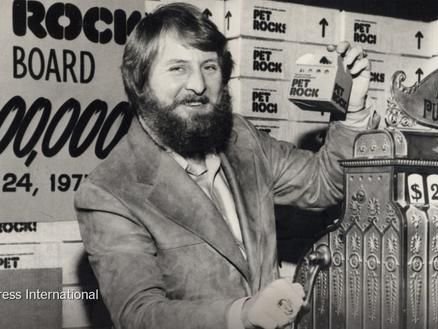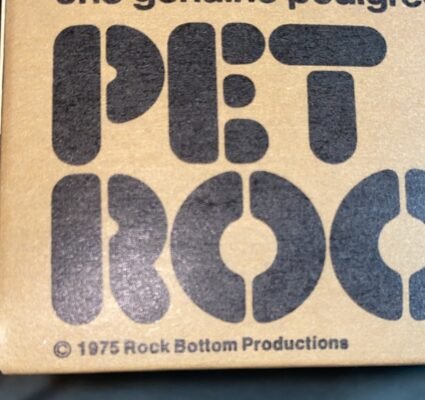Business History, Collectibles and Investments, Marketing History
The Pet Rock Millionaire: How One Man Sold Smooth Stones for $3.95 and Made a Fortune
The Inception of the Pet Rock Craze
The Pet Rock phenomenon began in the mid-1970s, a unique creation stemmed from the innovative mind of Gary Dahl, an advertising executive. Amidst a cultural backdrop defined by consumerism and a growing penchant for novelty items, Dahl conceptualized the idea of selling smooth rocks as pets. The simplicity of the concept was deliberately crafted to resonate with a society increasingly tired of complex and demanding pets, offering an absurd yet humorous alternative—an inanimate stone.
Dahl’s brainstorming process was rooted in his recognition of a niche market that craved novelty. He posited that much of the pet ownership burden stemmed from the need for care and companionship that many individuals, particularly urban dwellers, found daunting. By presenting a rock as an effortless pet, Dahl tapped into this sentiment, offering a product requiring zero maintenance. The irony and satire embedded in adopting such a mundane object as a beloved companion appealed richly to the public’s sense of humor and longing for simplicity.
The marketing strategies employed by Dahl were pivotal in transforming the Pet Rock into a cultural phenomenon. He packaged each rock in a cardboard box designed to resemble a pet carrier, complete with ventilation holes and a humorous instruction manual on how to care for one’s new pet. This not only enhanced the perceived value but also fueled its appeal as a quirky gift item. Moreover, clever advertising highlighted the absurdity of the Pet Rock, which generated significant media attention and widespread public curiosity. The intersection of creative marketing and societal trends created a perfect storm, propelling the Pet Rock into a formidable success story and marking one of the most bizarre, yet memorable, moments in consumer history.

Marketing Genius: How a Rock Became a Sensation
In the realm of marketing, few products have achieved the level of iconicity as the Pet Rock, introduced by Gary Dahl in the mid-1970s. The success of this quirky product stemmed not just from its novelty but from a series of innovative marketing strategies that transformed a simple rock into a cultural phenomenon. Dahl understood the importance of branding, and he brilliantly crafted the image of his product. The packaging, resembling a pet carrier, was intentional; it infused the idea of ownership and care, making customers feel as if they were purchasing a genuine pet.
The care instructions that accompanied each Pet Rock were pivotal to its marketing genius. These whimsical directives humorously outlined how to care for a rock, thereby instilling a sense of responsibility for something seemingly inanimate. This juxtaposition of the ordinary with the absurd not only appealed to consumers’ sense of humor but also contributed to the overall charm of the Pet Rock, enhancing its appeal. Dahl’s clever copywriting resonated with a wide audience, allowing the product’s concept to flourish in both casual conversation and social media discourse long before the advent of platforms like Instagram or Twitter.
Advertising played a crucial role as well. Dahl used unconventional advertising methods that captured widespread attention. His ads were strategically placed in publications and aired on television, creating buzz around the product. The use of humor in these advertisements made them memorable and shared—essentially creating word-of-mouth marketing without the need for a traditional marketing budget. Additionally, media appearances, including national talk shows, amplified reach and curiosity, resulting in a spike in sales that exceeded expectations.
Overall, Gary Dahl’s innovative marketing tactics not only launched the Pet Rock into stardom but also left a lasting impact on marketing strategies in consumer product launch efforts. The clever integration of humor, branding, and media presence set a benchmark for creative marketing campaigns, proving that sometimes, the simplest ideas can capture the imagination of millions.

Financial Success and Cultural Impact
The Pet Rock venture, initiated by Gary Dahl in the 1970s, marks one of the most remarkable phenomena in consumer goods history. Launched in 1975, the concept was ingeniously simple: a box containing a rock, complete with breathing holes and care instructions. Priced at $3.95, this unusual product managed to become a massive success, with sales figures soaring to over 1.5 million units within just six months. The Pet Rock generated approximately $7 million in revenue, leading Dahl to achieve a level of financial success that few entrepreneurs could have anticipated from selling a common stone.
The profit margins for the Pet Rock were astronomical, as the materials involved were virtually cost-free. Rocks could be sourced locally, and the packaging—crafted to resemble a pet carrier—was inexpensive. This unique combination of low production costs and high demand allowed Dahl to amass considerable wealth, transforming him into a millionaire almost overnight. His story illustrates not only the potential of unconventional business ideas but also how cleverly marketed novelty items can lead to significant financial rewards.

Lessons Learned from the Pet Rock Phenomenon
The remarkable journey of the Pet Rock offers several invaluable lessons for contemporary entrepreneurs and marketers. At its core, the Pet Rock phenomenon underscores the transformative power of creativity in product development. Gary Dahl, the creator of the Pet Rock, ingeniously turned an everyday object into a coveted novelty item. This serves as a reminder that innovation often stems from seeing potential where others may overlook it. By fostering a mindset that prioritizes creativity, businesses can identify unique ideas that resonate with consumers, leading to successful marketing campaigns.
Furthermore, understanding market trends is a critical takeaway from this phenomenon. The Pet Rock emerged during a period when consumers were increasingly drawn to simplicity and novelty. Ashifting consumer mindset can reveal untapped opportunities for new products. Businesses should remain vigilant and analyze the changing preferences of their target audience. By conducting thorough market research, entrepreneurs can align their offerings with emerging trends and thus enhance the chances of success.
The Pet Rock also illustrates the effectiveness of humor and simplicity in marketing. The straightforward concept, paired with a light-hearted advertising approach, made it accessible and engaging for a wide audience. Marketers should aim to convey their messages clearly and concisely, avoiding overly complex narratives. This approach not only enhances consumer understanding but also fosters a strong emotional connection with the product. In a world often saturated with sophisticated marketing tactics, returning to basic humor and relatability can effectively capture attention.
Lastly, recognizing consumer behavior is paramount. The Pet Rock captured the public’s imagination by appealing to their desire for novelty and humor. Successful businesses understand the importance of creating products that resonate emotionally with consumers, even if they appear unconventional. By embracing these lessons gleaned from the Pet Rock story, entrepreneurs can cultivate innovative ideas, adapt to market dynamics, and engage consumers in meaningful ways.
Business and Finance
🏢 Vandelay Industries Unisex Sweatshirt – Importing. Exporting. Comfort.
Business and Finance
Business and Finance
Business and Finance
₿🔥 Bitcoin Logo Unisex T-Shirt – Crypto Style, Classic Comfort
Business and Finance
🦈⚓ Quint’s Shark Fishing Unisex T-Shirt – Amity’s Finest Since ‘75
Business and Finance
Business and Finance
“Business Goose” Unisex T-Shirt – Professional Chaos in Style
Business and Finance

















